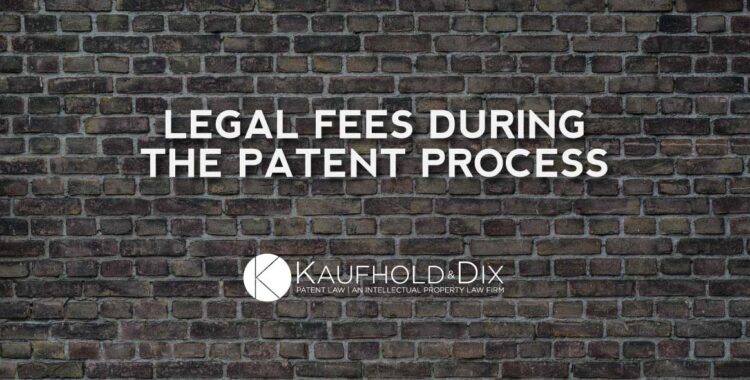How Legal Fees are Typically Paid During the Patent Process
Inventors make money by making and selling products based on inventions or by licensing an invention to business entities. To market an invention for a potential license, the inventor will need to shop the idea around to interested parties. But by pitching the invention to potential investors, the inventor may jeopardize any rights to it. Disclosing an idea to a third party runs the risk of potentially losing any rights either by it being copied or because the disclosure starts a statutory clock requiring a filing for protection within one year of making it public. In both cases, filing a patent application before telling anyone about the idea is the best way to ensure an inventor keeps the rights to their invention.
However, many inventors and small businesses avoid filing for patent protection because they are wary of the perceived costs. Don’t let this be the reason to fail to protect intellectual property. Patent filing can be both cost-effective and profitable. A patent is an asset, one that increases the value of an idea, allows profit to be made from it, and which typically is one of the least expensive acts taken when bringing a product to market.
Applying for a patent can seem like a daunting task, but obtaining a patent need not be overly confusing or expensive. An effective filing strategy and planning ahead will ensure the reaping of benefits while keeping costs at a minimum.
First, the Basics
The type of utility patent application filed will have a significant impact on the total filing costs and is partially determined by a client’s needs. Typically, provisional patent applications are less expensive than non-provisional patents because they do not require formal drawings or a complete claim set. Thus, they are not a “complete” application in some respects, but this allows for a faster and less expensive way to obtain the status of “patent pending” for an invention. The provisional application provides one year of patent pending status before it will go abandoned. Any rights it did protect will be lost unless a non-provisional application is filed that is tied to the provisional application.
The upside of a provisional application, then, is that its lower cost will buy an inventor a year of being patent pending, during which the invention can be market-tested or licensed to a third party. The downside is that the patent pending status only lasts for a year, and a provisional application will never become a patent. Therefore, if the project is a long-termed one and a patent is one of the ultimate goals, it may be wise to skip the provisional application since doing both will cost more money and will increase the time it takes to be awarded a patent.
One final note, a provisional patent application should never be written by a non-attorney because it is the basis of the rights in the invention and thus should be viewed as important as a non-provisional application. A provisional application is not simple, quick, or easy – it is as often as complicated as the non-provisional application it precedes. Many inventors have lost their rights by filing their own provisional application only to learn too late that it was fatally flawed and unwisely relied upon. Therefore, an inventor should only go the provisional route when it makes sense for their particular needs, and such a task should only be undertaken by a trained patent professional.
How Much Does a Non-provisional Patent Application Cost?
Beware of any cheap and easy shortcuts to a utility patent. One should approach a non-provisional patent the same way they would an investment. As with any investment, it’s the long-term that matters, and spending the correct amount of money now will save money and increase the value of the investment in the future.
Attorney fees will no doubt take up the most considerable portion of patent application writing and prosecution costs, but because an issued patent could become exceptionally valuable to an individual inventor or even an entire industry, it is essential that the work be performed properly by a skilled writer.
Often patent attorneys charge by the hour, which can become very expensive, especially for start-ups and small businesses with very limited intellectual property budgets. Depending on the law firm, additional fees may enter the picture and include fees to prepare drawings for the application and miscellaneous actions such as mailings and phone calls by both the attorney and their assistants. Fees owed to the USPTO to process your application and ultimately issue your patent are required as well, though these fees are often slight compared to the attorney’s fees.
Keep in mind that attorneys reduce risk by charging an hourly rate because whatever time they spend on the application will be compensated. On the other hand, an hourly rate increases the risk borne by the client. A client may be liable to pay higher fees than expected, and hourly rates make budgeting a nightmare. While some patent attorneys will offer a flat fee to write a patent application, the flat fee ends there. Since the USPTO will most definitely reject all or portions of an application, arguments, called office actions, will be required during the patent application process. These arguments can cost a client many thousands of dollars and typically come at any time between twelve and thirty months after the filing of the application. Thus, what sounds like a reasonable amount up front can quickly balloon to exceedingly high costs.
All factors above considered, a flat rate billing system is the most cost-effective and up-front solution for a business or independent inventor. Fixed or flat rate billing systems ensure that a client knows the totality of the costs upfront and will not be surprised by billings that were unforeseen and potentially economically painful.
Let’s use our law firm, Kaufhold & Dix, as an example. All patent filing and prosecution services are included in a flat fee agreed upon before the process even starts. Accordingly, the total costs of filing and prosecuting an application for a non-provisional patent with Kaufhold & Dix will typically be in the range from around $4500 to $7000, depending primarily on the complexity and type of invention involved. These fees include the drafting of the figures used in the application and arguments with the USPTO up to the first of an allowance or a final rejection. The only costs not covered are any fees paid directly to the USPTO.
We have found that our clients are most pleased when they are aware of the total costs involved and the lack of surprise or hidden fees that can so often come with legal actions. As we like to say, we know what the cost of doing business is, so should our clients.
Intellectual Property Playbook
An Entrepreneur's Guide To Patents, Trademarks, and Copyrights GET THE PLAYBOOK
Make Sure Your Work Is Protected – Work With Kaufhold & Dix
If you’re considering filing for a patent but are wary of the costs, get in touch with us for a free consultation. We will help you work out the best options available to you and your business.






